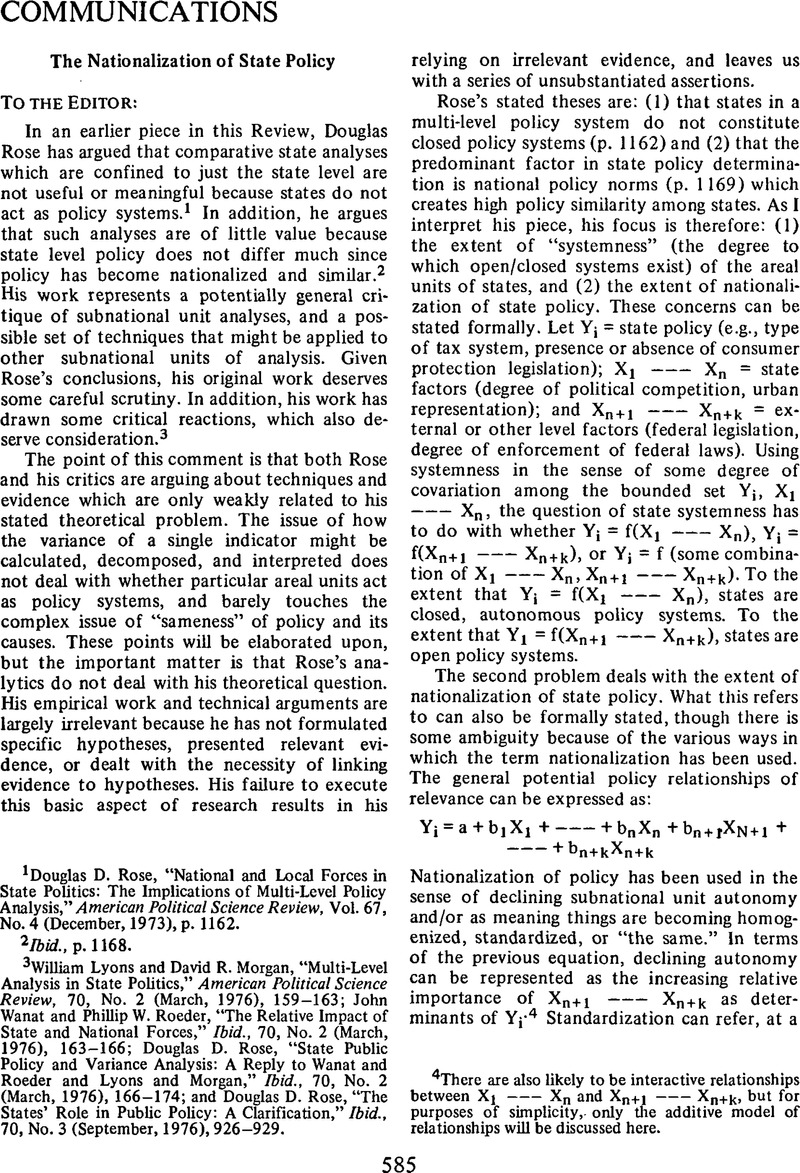No CrossRef data available.
Published online by Cambridge University Press: 01 August 2014

page 585 note 1 Rose, Douglas D., “National and Local Forces in State Politics: The Implications of Multi-Level Policy Analysis,” American Political Science Review, Vol. 67, No. 4 (December, 1973), p. 1162 CrossRefGoogle Scholar.
page 585 note 2 Ibid., p. 1168.
page 585 note 3 Lyons, William and Morgan, David R., “Multi-Level Analysis in State Politics,” American Political Science Review, 70, No. 2 (March, 1976), 159–163 CrossRefGoogle Scholar; John Wanat and Phillip W. Roeder, “The Relative Impact of State and National Forces,” Ibid., 70, No. 2 (March, 1976), 163–166; Douglas D. Rose, “State Public Policy and Variance Analysis: A Reply to Wanat and Roeder and Lyons and Morgan,” Ibid., 70, No. 2 (March, 1976), 166–174; and Douglas D. Rose, “The States' Role in Public Policy: A Clarification,” Ibid., 70, No. 3 (September, 1976), 926–929.
page 586 note 4 There are also likely to be interactive relationships between X1 --- Xn and Xn+1 --- Xn+k, but for purposes of simplicity, only the additive model of relationships will be discussed here.
page 585 note 5 I have considerable sympathy for the statements, and have argued for the importance of their examination in Stonecash, Jeff, “Urban Policy Analysis, Systems Assumptions, and Multiple Levels of Influence,” Publius, Vol. 7, No. 1 (Winter, 1977)Google Scholar.
page 586 note 6 I am indebted to Heywcod Sanders, The Institute of Government and Public Affairs, The University of Illinois, for contributing to my understanding of the statistical analysis in Rose's work.
page 586 note 7 In regard to this point, and the first, it may be that I am in error in criticizing his analysis for it may be that he is purposefully doing this to demonstrate that prior analyses taking this approach using such aggregated individual level data are incorrect. While that is possible (see p. 1166), it does not seem to be the case on the basis of the data and analysis used on pp. 1164–1165. I am unable to determine what is finally meant regarding the use of such data.
page 586 note 8 In a personal communication with me, Doug Rose has indicated that he has gone beyond the limitations of variance components analyses and examined structural relationships in Rose, Douglas D., “Citizen Preference and Public-Policy in the American States,” in Perspectives on Public Policy-Making, Gwyn, William B. and Edwards, George C. III (eds.), Tulane Studies in Political Science, Vol. XV (New Orleans: Tulane University, 1975)Google Scholar.
Comments
No Comments have been published for this article.